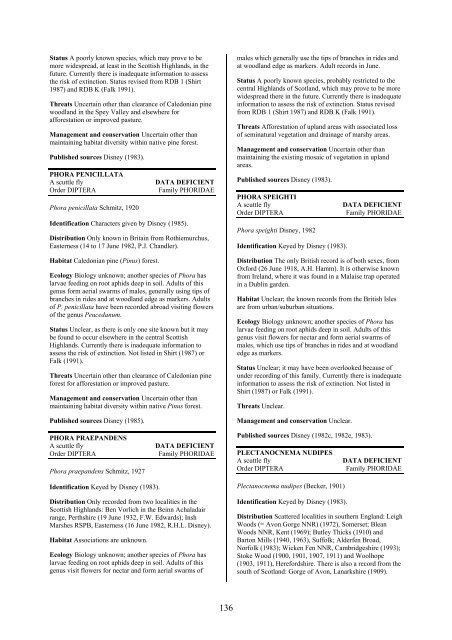Part 2: Nematocera and Aschiza not dealt with by Falk (1991) - JNCC
Part 2: Nematocera and Aschiza not dealt with by Falk (1991) - JNCC
Part 2: Nematocera and Aschiza not dealt with by Falk (1991) - JNCC
You also want an ePaper? Increase the reach of your titles
YUMPU automatically turns print PDFs into web optimized ePapers that Google loves.
Status A poorly known species, which may prove to be<br />
more widespread, at least in the Scottish Highl<strong>and</strong>s, in the<br />
future. Currently there is inadequate information to assess<br />
the risk of extinction. Status revised from RDB 1 (Shirt<br />
1987) <strong>and</strong> RDB K (<strong>Falk</strong> <strong>1991</strong>).<br />
Threats Uncertain other than clearance of Caledonian pine<br />
woodl<strong>and</strong> in the Spey Valley <strong>and</strong> elsewhere for<br />
afforestation or improved pasture.<br />
Management <strong>and</strong> conservation Uncertain other than<br />
maintaining habitat diversity <strong>with</strong>in native pine forest.<br />
Published sources Disney (1983).<br />
PHORA PENICILLATA<br />
A scuttle fly<br />
Order DIPTERA<br />
Phora penicillata Schmitz, 1920<br />
DATA DEFICIENT<br />
Family PHORIDAE<br />
Identification Characters given <strong>by</strong> Disney (1985).<br />
Distribution Only known in Britain from Rothiemurchus,<br />
Easterness (14 to 17 June 1982, P.J. Ch<strong>and</strong>ler).<br />
Habitat Caledonian pine (Pinus) forest.<br />
Ecology Biology unknown; a<strong>not</strong>her species of Phora has<br />
larvae feeding on root aphids deep in soil. Adults of this<br />
genus form aerial swarms of males, generally using tips of<br />
branches in rides <strong>and</strong> at woodl<strong>and</strong> edge as markers. Adults<br />
of P. penicillata have been recorded abroad visiting flowers<br />
of the genus Peucedanum.<br />
Status Unclear, as there is only one site known but it may<br />
be found to occur elsewhere in the central Scottish<br />
Highl<strong>and</strong>s. Currently there is inadequate information to<br />
assess the risk of extinction. Not listed in Shirt (1987) or<br />
<strong>Falk</strong> (<strong>1991</strong>).<br />
Threats Uncertain other than clearance of Caledonian pine<br />
forest for afforestation or improved pasture.<br />
Management <strong>and</strong> conservation Uncertain other than<br />
maintaining habitat diversity <strong>with</strong>in native Pinus forest.<br />
Published sources Disney (1985).<br />
males which generally use the tips of branches in rides <strong>and</strong><br />
at woodl<strong>and</strong> edge as markers. Adult records in June.<br />
Status A poorly known species, probably restricted to the<br />
central Highl<strong>and</strong>s of Scotl<strong>and</strong>, which may prove to be more<br />
widespread there in the future. Currently there is inadequate<br />
information to assess the risk of extinction. Status revised<br />
from RDB 1 (Shirt 1987) <strong>and</strong> RDB K (<strong>Falk</strong> <strong>1991</strong>).<br />
Threats Afforestation of upl<strong>and</strong> areas <strong>with</strong> associated loss<br />
of seminatural vegetation <strong>and</strong> drainage of marshy areas.<br />
Management <strong>and</strong> conservation Uncertain other than<br />
maintaining the existing mosaic of vegetation in upl<strong>and</strong><br />
areas.<br />
Published sources Disney (1983).<br />
PHORA SPEIGHTI<br />
A scuttle fly<br />
Order DIPTERA<br />
Phora speighti Disney, 1982<br />
Identification Keyed <strong>by</strong> Disney (1983).<br />
DATA DEFICIENT<br />
Family PHORIDAE<br />
Distribution The only British record is of both sexes, from<br />
Oxford (26 June 1918, A.H. Hamm). It is otherwise known<br />
from Irel<strong>and</strong>, where it was found in a Malaise trap operated<br />
in a Dublin garden.<br />
Habitat Unclear; the known records from the British Isles<br />
are from urban/suburban situations.<br />
Ecology Biology unknown; a<strong>not</strong>her species of Phora has<br />
larvae feeding on root aphids deep in soil. Adults of this<br />
genus visit flowers for nectar <strong>and</strong> form aerial swarms of<br />
males, which use tips of branches in rides <strong>and</strong> at woodl<strong>and</strong><br />
edge as markers.<br />
Status Unclear; it may have been overlooked because of<br />
under recording of this family. Currently there is inadequate<br />
information to assess the risk of extinction. Not listed in<br />
Shirt (1987) or <strong>Falk</strong> (<strong>1991</strong>).<br />
Threats Unclear.<br />
Management <strong>and</strong> conservation Unclear.<br />
PHORA PRAEPANDENS<br />
A scuttle fly<br />
Order DIPTERA<br />
Phora praep<strong>and</strong>ens Schmitz, 1927<br />
DATA DEFICIENT<br />
Family PHORIDAE<br />
Published sources Disney (1982c, 1982e, 1983).<br />
PLECTANOCNEMA NUDIPES<br />
A scuttle fly<br />
DATA DEFICIENT<br />
Order DIPTERA<br />
Family PHORIDAE<br />
Identification Keyed <strong>by</strong> Disney (1983).<br />
Distribution Only recorded from two localities in the<br />
Scottish Highl<strong>and</strong>s: Ben Vorlich in the Beinn Achaladair<br />
range, Perthshire (19 June 1932, F.W. Edwards); Insh<br />
Marshes RSPB, Easterness (16 June 1982, R.H.L. Disney).<br />
Habitat Associations are unknown.<br />
Ecology Biology unknown; a<strong>not</strong>her species of Phora has<br />
larvae feeding on root aphids deep in soil. Adults of this<br />
genus visit flowers for nectar <strong>and</strong> form aerial swarms of<br />
Plectanocnema nudipes (Becker, 1901)<br />
Identification Keyed <strong>by</strong> Disney (1983).<br />
Distribution Scattered localities in southern Engl<strong>and</strong>: Leigh<br />
Woods (= Avon Gorge NNR) (1972), Somerset; Blean<br />
Woods NNR, Kent (1969); Butley Thicks (1910) <strong>and</strong><br />
Barton Mills (1940, 1963), Suffolk; Alderfen Broad,<br />
Norfolk (1983); Wicken Fen NNR, Cambridgeshire (1993);<br />
Stoke Wood (1900, 1901, 1907, 1911) <strong>and</strong> Woolhope<br />
(1903, 1911), Herefordshire. There is also a record from the<br />
south of Scotl<strong>and</strong>: Gorge of Avon, Lanarkshire (1909).<br />
136
















